The Sherrif Security Indicator (TSSI) is an annual online survey that is organized to commemorate National Cyber Security Awareness Month. TSSI researches the most critical security concerns of residents of Ghana. This year’s survey is the third edition of TSSI.
TSSI asks respondents to show their greatest and least security concerns from a list of security threats including disaster/epidemic, hacking, inability to meet financial obligations, mobile money fraud, payment card fraud, personal safety, security of online banking/shopping, national security, and impersonation. We should note that, because of the rampant cases of mobile money fraud, this year’s edition introduced mobile money fraud as one of the security threats.
Methodology
The survey was conducted using Google Forms, which was shared with residents of Ghana via social media and email. The form was configured to prevent respondents from completing the form more than once. Hence, respondents could not complete the forms multiple times.
The survey was conducted for 6 weeks; from 5th September 2022 to 15th October 2022. Out of the approximately 2000 persons targeted for this study, 390 responses were received.
The respondents were asked the following questions:
- What is your gender?
- What is your age range?
- What is your highest level of education?
- Which of the 9 security factors is of greatest concern to you?
- Which of the 9 security factors is of least concern to you?
The results from the survey were analyzed using statistical software.
Results
This section discusses the respondents’ responses to the 5 questions. Each subsection addresses each of the answers.
Gender
Out of the 390 respondents, the majority were males. Females made up only 25%, as shown in figure 1.
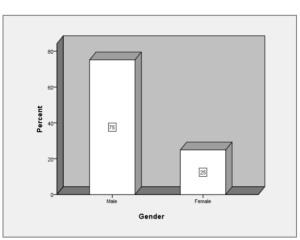
Age
Most of the respondents were between ages 26-35, whilst those above 55 years made up only 2%. None of the respondents were below 18 years. Figure 2 provides the detailed age distribution.
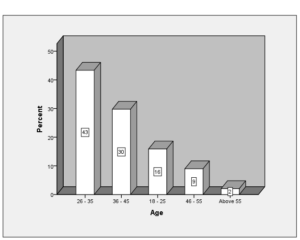
Educational level
Most of the respondents (92%) had tertiary education. Figure 3 provides the detailed educational qualifications of the respondents.
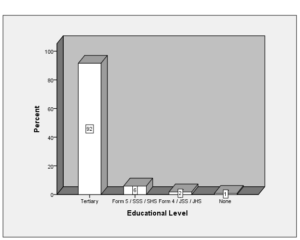
Greatest security threat
Cumulatively (i.e., irrespective of the demographics), most of the respondents ranked personal safety as their greatest concern among the 9 security threats, followed closely by their inability to meet their financial obligations and national security. Figure 4 provides detailed responses.
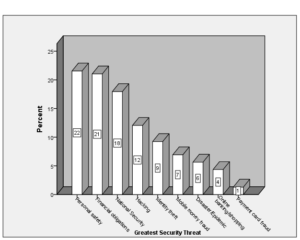
In segregating the response by gender, most of the males ranked their inability to meet financial obligations as their greatest security concern, followed closely by national security and personal safety. The greatest security concern for the females was their personal safety, followed by their inability to meet financial obligations, and identity theft.
Also, the greatest security concern of most of the respondents between the ages of 18-25 was personal safety, followed by their inability to meet financial obligations. Those between the ages of 26-35 indicated their inability to meet financial obligations as their greatest security concern, followed by national security. The ages 36-45 and 46-55 showed personal safety as their greatest security concern, followed by national security. Those above 55 years indicated hacking as their greatest security concern, followed by identity theft and personal safety (same position).
Least security concern
Cumulatively, most of the respondents ranked mobile money fraud as their least security concern, followed by their inability to meet financial obligations, and disaster/epidemic.
Figure 5 provides detailed responses.
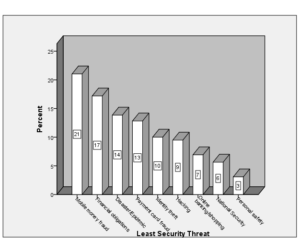
Most of the males ranked mobile money fraud as their least security concern, followed by their inability to meet financial obligations, and disaster/epidemic. The females ranked their inability to meet financial obligations as their least security concern, followed by disaster/epidemic, identity theft, and mobile money fraud (in the same position).
Most of the respondents in all age ranges ranked mobile money fraud as their least security concern, followed by their inability to meet financial obligations.
Analysis
Despite the numerous analysis that could be drawn from the findings, this article focuses on a few of interest.
The findings indicate that, out of the 9 security threats, the respondents’ personal safety was their greatest security concern. The gender and age of the respondents influenced their security concerns. Males were most concerned about their inability to meet financial obligations, whilst females were most concerned about their personal safety. Those above 55 years had different security concerns than their counterparts. Their greatest concern was hacking into their systems/accounts.
Mobile money fraud was of the least concern to the respondents. Gender also influenced the respondents’ least security concerns. Males were least concerned about mobile money fraud, whilst females were least concerned about their inability to meet financial obligations. Age had no influence on the least security concerns of the respondents. Most of the respondents in all age ranges ranked mobile money fraud as their least security concern.
It is also clear from the findings that information security-related concerns were not the top concerns of the respondents. Information security-related threats were ranked somewhat in the median, both between the greatest and least security concerns.
Comparing the findings of the greatest security concern with the least security concern clearly shows the fact that personal safety is indeed paramount to the respondents. It is, however, intriguing to note that the second greatest security concern (inability to meet financial obligations) also turns out to be the second least security concern.
Constraints
Due to the medium used to administer the survey, the views of individuals without access to smartphones, computers, and the internet could not be solicited.
Although the number of responses received this year was 27% more than last year, the responses were not encouraging, compared to the targeted respondents in 2000.
Conclusion
The top three greatest security concerns for this year’s survey were the same as for the previous edition. The only difference is personal safety moved from the second position in the previous survey to the top position this year.
Although information security-related threats did not show in the top three greatest security concerns, they were also not considered in the top three of the least security concerns, as was witnessed in last year’s survey. It can therefore be deduced that; the respondents are appreciating the grave impacts of information security-related threats.
We ought to take cognizant of the fact that information security-related threats can degenerate into other security threats, as we witnessed in the case of the Electricity Company of Ghana hack, in September this year.
To overcome the constraints to improve this survey; logistical, human, and financial support would be much appreciated from individuals and organizations.
We are extremely grateful to all those who supported this year’s survey, especially our respondents. We hope to receive your support in the subsequent editions of TSSI.
The author is an Information Security Governance, Risk and Compliance Professional, and Director of Communications, IIPGH)
For comments, contact author [email protected] | +233243835912










